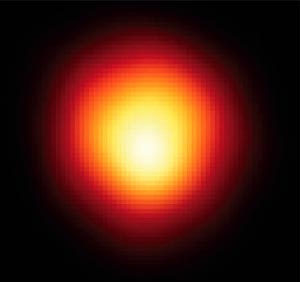New measurements of unstable nuclei caught in the act of decay have gone a long way towards resolving long-standing questions about the triple-alpha process that creates carbon nuclei. The results, from experiments at CERN’s ISOLDE facility and the IGISOL facility at the University of Jyväskylä in Finland, were recently published in Nature (Fynbo et al. 2005).

Although physicists first discovered how stars build up atomic nuclei in the 1950s, they have been unable to pin down key properties of carbon nuclei that determine the triple-alpha rate over a wide temperature range. Now, thanks to the isotope separate online method for creating and isolating isotopes (largely developed at CERN) and to developments in particle detectors, a team of researchers has been able to tackle this problem.
The collaboration – involving more than 30 people at eight European universities and institutes, including CERN – first isolated short-lived isotopes of 12B and 12N. These transform via beta decay into 12C, populating resonances in carbon that then break into three alpha particles. By measuring precisely the timing and energies of alpha particles emitted by the samples, the team was able to infer the energy, spin and parity of the carbon nuclei just before decay.
The triple-alpha process is more probable only because 12C can exist at particular energies close to the combined energies of 8Be and 4He. At the temperature levels in most stars – 108 to 109 K – carbon’s so-called Hoyle resonance at 7.65 MeV determines the triple-alpha rate. But at higher and lower temperatures, other resonances – some observed, some theorized – come into play.
In the recent experiments, the researchers were able to pin down the spin and parity of the wide resonance near 10 MeV. First observed in 1958, it had been measured at 10.1 MeV (width 3 MeV), but its spin-parity could be determined only as either 0+ or 2+. The new study puts this resonance at 11.23(5) MeV with width 2.5(2) MeV, and finds its spin-parity to be 0+.
The group also looked for a long-theorized 2+ resonance at 9.1 MeV, width 0.56 MeV. If it existed, it would play a dominant role at temperatures of more than 109 K, but there was no evidence for it. However, to fit the data, the team needed to introduce a 2+ resonance at 13.9(3) MeV with width 0.7(3) MeV. They were then able to calculate a revised triple-alpha rate over a wide temperature range, from 107 to 1010 K. Compared with the previously calculated rate, the new rate is significantly faster at low temperatures (107 to 108 K); the same in the middle range dominated by the Hoyle resonance; and slower at high temperatures (109 to 1010 K).
The revised rate has several astrophysical implications. One such is that in the universe’s first stars, which began with no carbon and burned at relatively low temperatures, the only form of hydrogen fusion would be through the proton-proton chain. Once enough carbon had formed through the triple-alpha process, however, the CNO (carbon-nitrogen-oxygen) chain could begin. With the higher triple-alpha rate, this evolution might have taken only half as long as was previously thought. Also, in type-II supernovae, the lower rate above 109 K implies that the fraction of 56Ni produced would be less than previously thought.
Further reading
H Fynbo et al. 2005 Nature 433 136.





